Rick Just's Blog, page 132
March 19, 2021
Street View, Blackfoot
The colorized photo of Main Street, Blackfoot on top below is probably from 1909 when the city was celebrating the Diamond Jubilee of the first Protestant service west of the Rocky Mountains being conducted in a grove near Fort Hall, and the first raising of the United States flag in the Pacific Northwest. I wrote about that in an earlier blog.
I noticed that the postcard photo doesn’t look a lot different from Main Street in Blackfoot today, so I grabbed a Google Streetview capture for comparison. It’s below the postcard.
If you follow with your finger straight down from where Main Street is printed on the postcard, you can just make out where Bridge Street intersects with it. Both buildings on either side of Bridge are still there today though the one on the far left has been much modified. Both have 45-degree corner entrances, though that’s difficult to make out in the contemporary photo.
Working back toward the right you can still make out the next two buildings, which are little changed. Then we see that the next three buildings in the 1909 photo have a metal facade tying them all together in the contemporary photo. Past the 1910 Groceries building we see a single gray building with a distinctive cornice running along the top. In the contemporary photo we see that part of the façade of that building has been modified to make it look like two distinct buildings.
The first photo was probably taken from near the train station, which is today the Idaho Potato Museum.

I noticed that the postcard photo doesn’t look a lot different from Main Street in Blackfoot today, so I grabbed a Google Streetview capture for comparison. It’s below the postcard.
If you follow with your finger straight down from where Main Street is printed on the postcard, you can just make out where Bridge Street intersects with it. Both buildings on either side of Bridge are still there today though the one on the far left has been much modified. Both have 45-degree corner entrances, though that’s difficult to make out in the contemporary photo.
Working back toward the right you can still make out the next two buildings, which are little changed. Then we see that the next three buildings in the 1909 photo have a metal facade tying them all together in the contemporary photo. Past the 1910 Groceries building we see a single gray building with a distinctive cornice running along the top. In the contemporary photo we see that part of the façade of that building has been modified to make it look like two distinct buildings.
The first photo was probably taken from near the train station, which is today the Idaho Potato Museum.

Published on March 19, 2021 04:00
March 18, 2021
The Idaho Hot Spot
What do you think of when you hear the term “Idaho hot spot?” Maybe a new restaurant or trendy bar? Not nearly as hot as the subject of today’s post.
If you look at a topographic map of Idaho you can’t help but notice the swoop of the Snake River as it moves east to west through the southern part of the state. That’s called the Snake River Plain. It would be natural to assume that the Snake River created it, perhaps as it meandered back and forth through geologic time. That assumption would be wrong. The Snake River Plain was created by a lot of geological forces, including water erosion, but it’s primarily a signature left behind by a hot spot beneath the earth’s crust.
The crust of the earth is moving west in relation to this hot spot, so its impact is moving east. Think of the hot spot as being stationary while the crust moves west. In the illustration you can see where the hot spot was 16 million years ago along the Oregon/Nevada border. As the crust continued west, the stationary hot spot effectively move east. It “entered” the state some 15 million years ago, was somewhere around Bruneau Dunes about 12 million years ago, and was parked under Craters of the Moon National Monument about 7 to 10 million years ago.
As the hot spot moved, it produced a lot of volcanic activity on the surface. The Craters area is one visible indication of this. The area known as Island Park is where the hot spot made a big showing about 5 million years ago. It left behind a couple of calderas, or collapsed volcanoes. The Henry’s Fork Caldera is between 18 and 23 miles across. That’s huge. Still, it comfortably fits INSIDE the Island Park Caldera, which is 50 to 65 miles wide. Upper Mesa Falls is where the water of the Henrys Fork splashes over the edge of the old volcano.
So, has the hot spot gone away? Nope. You can find it today under Yellowstone National Park heating up the geysers and hot pools and causing social media to come unglued whenever there is swarm of earthquakes.
By the way, this is the same thing that’s going on with the Hawaiian Islands. That hot spot acts of as the earth’s crust moves over the top of it, too. Since there is no land mass the resulting volcanic activity produces islands. One of the oldest islands, Kauai, is to the furthest west. As that hot spot moved—in relation to the crust—east, it created Oahu, Maui, and then the Big Island, Hawaii. That’s where the volcanic activity is today.
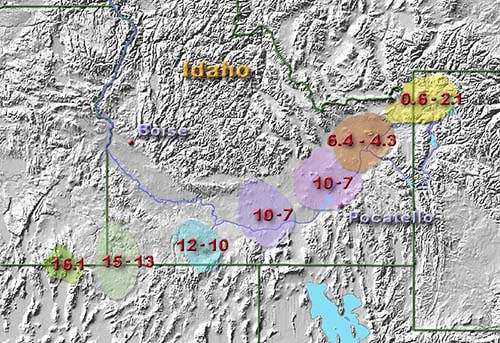 Past locations of the hot spot in millions of years.
Past locations of the hot spot in millions of years.
If you look at a topographic map of Idaho you can’t help but notice the swoop of the Snake River as it moves east to west through the southern part of the state. That’s called the Snake River Plain. It would be natural to assume that the Snake River created it, perhaps as it meandered back and forth through geologic time. That assumption would be wrong. The Snake River Plain was created by a lot of geological forces, including water erosion, but it’s primarily a signature left behind by a hot spot beneath the earth’s crust.
The crust of the earth is moving west in relation to this hot spot, so its impact is moving east. Think of the hot spot as being stationary while the crust moves west. In the illustration you can see where the hot spot was 16 million years ago along the Oregon/Nevada border. As the crust continued west, the stationary hot spot effectively move east. It “entered” the state some 15 million years ago, was somewhere around Bruneau Dunes about 12 million years ago, and was parked under Craters of the Moon National Monument about 7 to 10 million years ago.
As the hot spot moved, it produced a lot of volcanic activity on the surface. The Craters area is one visible indication of this. The area known as Island Park is where the hot spot made a big showing about 5 million years ago. It left behind a couple of calderas, or collapsed volcanoes. The Henry’s Fork Caldera is between 18 and 23 miles across. That’s huge. Still, it comfortably fits INSIDE the Island Park Caldera, which is 50 to 65 miles wide. Upper Mesa Falls is where the water of the Henrys Fork splashes over the edge of the old volcano.
So, has the hot spot gone away? Nope. You can find it today under Yellowstone National Park heating up the geysers and hot pools and causing social media to come unglued whenever there is swarm of earthquakes.
By the way, this is the same thing that’s going on with the Hawaiian Islands. That hot spot acts of as the earth’s crust moves over the top of it, too. Since there is no land mass the resulting volcanic activity produces islands. One of the oldest islands, Kauai, is to the furthest west. As that hot spot moved—in relation to the crust—east, it created Oahu, Maui, and then the Big Island, Hawaii. That’s where the volcanic activity is today.
 Past locations of the hot spot in millions of years.
Past locations of the hot spot in millions of years.
Published on March 18, 2021 04:00
March 17, 2021
Joseph Sherwood, Inventor
Yesterday I wrote a post about entrepreneur and Island Park pioneer Joseph Sherwood.
Sherwood built his own sawmill on the north shore of Henrys Lake using a canvas flume carrying water from ponds he had constructed for power. He was a mechanically minded man.
Did Sherwood have the first snowmobile in Idaho? I don’t know, but I’d like to hear if anyone knows of an earlier one. He received a patent, number 844,963 for his “auto snow-car" in 1907. He patterned it after a four runner, horse-drawn sled. A 1 ½ horsepower gasoline engine was connected gearbox and flywheel by a chain drive. Another set of chains wrapped around sprockets on a large wooden drum in the rear. That was the equivalent to the track on a modern snowmobile. To steer the contraption you moved the front runners from side to side by means of a lever.
The snow machine weighed something under 1,000 pounds. It wouldn’t win any races with a top speed of 12 miles per hour.
Sherwood didn’t apply for a patent on his car. He just built it. It was called “The Black Car.” He used magazine pictures as his construction guide.
The Sherwood store had been a stage stop for years. As motor vehicles began to appear in the Island Park area—his own was probably the first—Sherwood began selling gasoline and motor oil.
Joseph Sherwood died in 1919 due to complications from diabetes. The store he built continued in operation until the mid-1960s. The building has undergone extensive renovation and restoration. According to an article in the Rexburg Standard Journal, it may soon see another chapter in its history.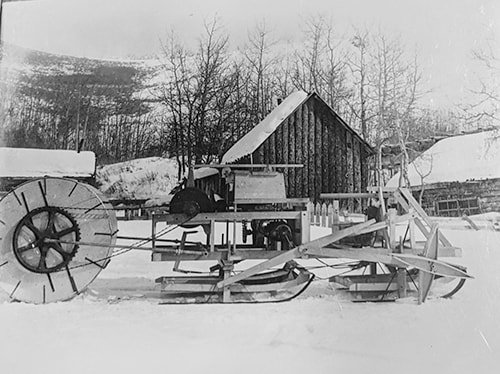 Joseph Sherwood’s snow machine.
Joseph Sherwood’s snow machine. 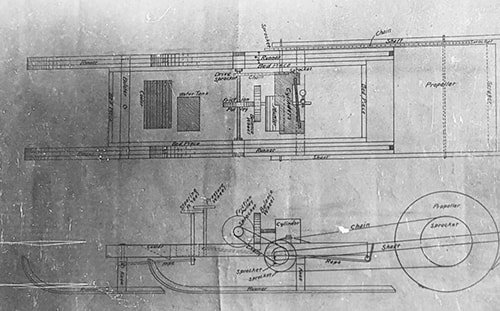 The schematic for Sherwood’s patented vehicle.
The schematic for Sherwood’s patented vehicle. 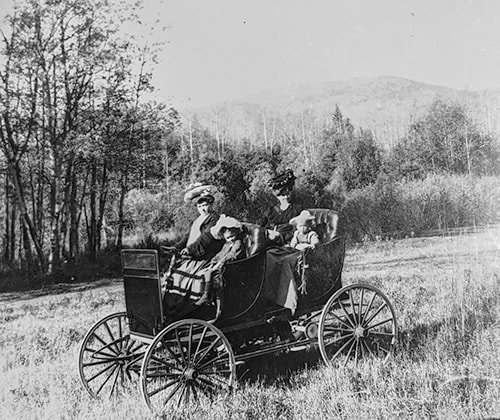 “The Black Car,” built by Joseph Sherwood.
“The Black Car,” built by Joseph Sherwood.
Sherwood built his own sawmill on the north shore of Henrys Lake using a canvas flume carrying water from ponds he had constructed for power. He was a mechanically minded man.
Did Sherwood have the first snowmobile in Idaho? I don’t know, but I’d like to hear if anyone knows of an earlier one. He received a patent, number 844,963 for his “auto snow-car" in 1907. He patterned it after a four runner, horse-drawn sled. A 1 ½ horsepower gasoline engine was connected gearbox and flywheel by a chain drive. Another set of chains wrapped around sprockets on a large wooden drum in the rear. That was the equivalent to the track on a modern snowmobile. To steer the contraption you moved the front runners from side to side by means of a lever.
The snow machine weighed something under 1,000 pounds. It wouldn’t win any races with a top speed of 12 miles per hour.
Sherwood didn’t apply for a patent on his car. He just built it. It was called “The Black Car.” He used magazine pictures as his construction guide.
The Sherwood store had been a stage stop for years. As motor vehicles began to appear in the Island Park area—his own was probably the first—Sherwood began selling gasoline and motor oil.
Joseph Sherwood died in 1919 due to complications from diabetes. The store he built continued in operation until the mid-1960s. The building has undergone extensive renovation and restoration. According to an article in the Rexburg Standard Journal, it may soon see another chapter in its history.
 Joseph Sherwood’s snow machine.
Joseph Sherwood’s snow machine.  The schematic for Sherwood’s patented vehicle.
The schematic for Sherwood’s patented vehicle.  “The Black Car,” built by Joseph Sherwood.
“The Black Car,” built by Joseph Sherwood.
Published on March 17, 2021 04:00
March 16, 2021
Josheph Sherwood, Entrepreneur
I’m going to write a couple of posts about Joseph Sherwood, an enterprising man who came to what is now known as the Island Park area in about 1889. Today I’ll focus on the entrepreneurial Sherwood. Tomorrow we’ll talk about Sherwood the inventor.
Joseph Sherwood built a store on the north shore of Henrys Lake. We don’t know a lot about the structure, except that it burned and was subsequently replaced in about 1899. As a community focal point, the store became the post office of Lake, Idaho. Sherwood was named the postmaster.
Along with his wife Susan, Sherwood built a going enterprise. They raised cattle and in something of a precursor to Idaho’s famous Magic Valley trout farms, Sherwood packaged fish caught by locals and shipped them off to customers in Montana and California. This was no small operation. Sherwood once wrote in a letter that “The amount of fish usually caught in winter here varies from 50 to 90,000 pounds.”
Sherwood also ran a sawmill that was powered by gravity-fed water running in a canvas flume from a series of ponds he had developed above his place. He sold lumber commercially and used the sawmill to build his store.
And what a building it was—and is. It has since been modified, but the structure built in 1899 was 55 feet wide, 37 feet deep, and 46 feet high. It contained 27 rooms. The general store and post office was on the first floor, along with a family living area. The second floor had four bedrooms for rental to overnight stagecoach guests, a display room for Sherwood’s taxidermy, a photographic darkroom, and a photo gallery. A half-story attic was used for storage.
The store and museum was the home base for Sherwood’s boats. He rented them and often took visitors out on the lake from his launch.
About that taxidermy… Sherwood took a correspondence course to learn how to do it. He shared his knowledge with his second wife, Ann, after Susan’s death. Together they set out to mount at least once specimen of every critter native to Island Park. That room full of taxidermy mounts was why the store was often called the Sherwood Museum.
To say that Joseph Sherwood was self-sufficient would be like saying there were a few fish in Henrys Lake. One story, told in the National Register of Historic Places application for his building, was about his medical skills. He delivered he and Ann’s children himself, including Clarence Sherwood, who told this story. One day his father was thrown from a wagon some distance from their home. Joseph Sherwood fashioned a splint for his leg, got back into his wagon, and drove home. When he got home, with Ann’s help he set his leg. Then he hopped back in the wagon and headed for St. Anthony to attend a board meeting of the local bank, where he served as president.
Tomorrow I’ll conclude the Joseph Sherwood story with a little bit about his inventions.
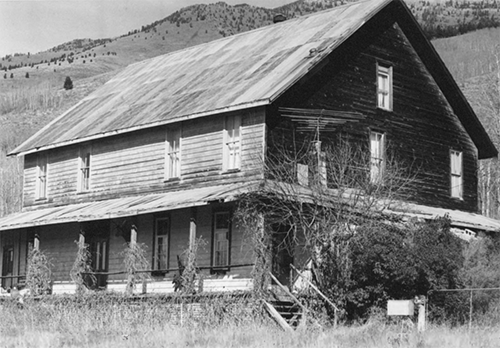 Joseph Sherwood’s store as it appeared in the application for its listing on the National Register of Historic Places. It was approved for that listing in 1996.
Joseph Sherwood’s store as it appeared in the application for its listing on the National Register of Historic Places. It was approved for that listing in 1996.
Joseph Sherwood built a store on the north shore of Henrys Lake. We don’t know a lot about the structure, except that it burned and was subsequently replaced in about 1899. As a community focal point, the store became the post office of Lake, Idaho. Sherwood was named the postmaster.
Along with his wife Susan, Sherwood built a going enterprise. They raised cattle and in something of a precursor to Idaho’s famous Magic Valley trout farms, Sherwood packaged fish caught by locals and shipped them off to customers in Montana and California. This was no small operation. Sherwood once wrote in a letter that “The amount of fish usually caught in winter here varies from 50 to 90,000 pounds.”
Sherwood also ran a sawmill that was powered by gravity-fed water running in a canvas flume from a series of ponds he had developed above his place. He sold lumber commercially and used the sawmill to build his store.
And what a building it was—and is. It has since been modified, but the structure built in 1899 was 55 feet wide, 37 feet deep, and 46 feet high. It contained 27 rooms. The general store and post office was on the first floor, along with a family living area. The second floor had four bedrooms for rental to overnight stagecoach guests, a display room for Sherwood’s taxidermy, a photographic darkroom, and a photo gallery. A half-story attic was used for storage.
The store and museum was the home base for Sherwood’s boats. He rented them and often took visitors out on the lake from his launch.
About that taxidermy… Sherwood took a correspondence course to learn how to do it. He shared his knowledge with his second wife, Ann, after Susan’s death. Together they set out to mount at least once specimen of every critter native to Island Park. That room full of taxidermy mounts was why the store was often called the Sherwood Museum.
To say that Joseph Sherwood was self-sufficient would be like saying there were a few fish in Henrys Lake. One story, told in the National Register of Historic Places application for his building, was about his medical skills. He delivered he and Ann’s children himself, including Clarence Sherwood, who told this story. One day his father was thrown from a wagon some distance from their home. Joseph Sherwood fashioned a splint for his leg, got back into his wagon, and drove home. When he got home, with Ann’s help he set his leg. Then he hopped back in the wagon and headed for St. Anthony to attend a board meeting of the local bank, where he served as president.
Tomorrow I’ll conclude the Joseph Sherwood story with a little bit about his inventions.
 Joseph Sherwood’s store as it appeared in the application for its listing on the National Register of Historic Places. It was approved for that listing in 1996.
Joseph Sherwood’s store as it appeared in the application for its listing on the National Register of Historic Places. It was approved for that listing in 1996.
Published on March 16, 2021 04:00
March 15, 2021
A Colorful Figure
Fred T. Dubois was one of the more colorful political figures in a state known for producing them in quantity. He would probably bristle at the term “colorful,” however, because skin color was one thing he had very narrow views about.
Dubois, who had a ranch near Blackfoot, began his political career by getting appointed U.S. Marshal for Idaho Territory in 1882. From that position, he successfully campaigned to disenfranchise Mormons from voting on the grounds that their practice of polygamy was against the law.
Next, Dubois ran as a Republican for the position of Congressional delegate from the territory, defeating the Democratic incumbent, John Hailey. He was in that position until 1890, when Idaho became a state. In those days U.S. Senators were elected by state legislators, and in Idaho Fred T. Dubois was elected as a Republican in 1891.
Dubois helped negotiate a treaty with the Nez Perce during his term in office, taking the opportunity to disparage the Bannock Tribe by calling them lazy and shiftless. Dubois served until 1896, when he was defeated.
In 1900, Dubois again ran for U.S. Senate, defeating his former ally George Shoup. It was a Democratic legislature that elected him, and he showed his thanks by becoming a Democrat a few months later. He is the only Idahoan who has served in the Senate as both a Democrat and a Republican.
Dubois had an anti-Mormon, anti-Indian reputation, and he added to that by showing his stripes as anti-Filipino, anti-black, anti-Japanese, anti-Chinese, etc. during his second term in the Senate.
The Idaho Legislature chose William Borah to replace Dubois in 1907. He would serve in the senate for 32 years.
Dubois died in 1930 and is buried in the Grove City Cemetery in Blackfoot (photo). Controversial as he was, Fred T. Dubois has two towns named after him, Dubois, Idaho and Dubois, Wyoming. The latter Dubois was given the moniker by the U.S. Postal Service, to the chagrin of residents who had another name in mind.
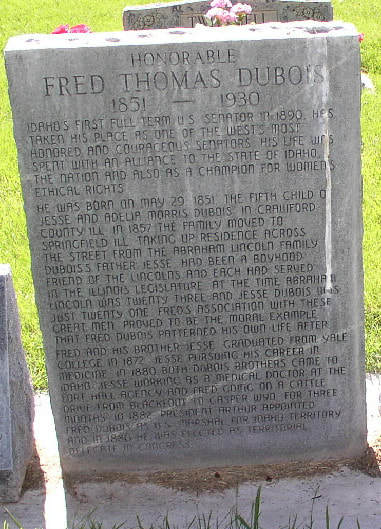
Dubois, who had a ranch near Blackfoot, began his political career by getting appointed U.S. Marshal for Idaho Territory in 1882. From that position, he successfully campaigned to disenfranchise Mormons from voting on the grounds that their practice of polygamy was against the law.
Next, Dubois ran as a Republican for the position of Congressional delegate from the territory, defeating the Democratic incumbent, John Hailey. He was in that position until 1890, when Idaho became a state. In those days U.S. Senators were elected by state legislators, and in Idaho Fred T. Dubois was elected as a Republican in 1891.
Dubois helped negotiate a treaty with the Nez Perce during his term in office, taking the opportunity to disparage the Bannock Tribe by calling them lazy and shiftless. Dubois served until 1896, when he was defeated.
In 1900, Dubois again ran for U.S. Senate, defeating his former ally George Shoup. It was a Democratic legislature that elected him, and he showed his thanks by becoming a Democrat a few months later. He is the only Idahoan who has served in the Senate as both a Democrat and a Republican.
Dubois had an anti-Mormon, anti-Indian reputation, and he added to that by showing his stripes as anti-Filipino, anti-black, anti-Japanese, anti-Chinese, etc. during his second term in the Senate.
The Idaho Legislature chose William Borah to replace Dubois in 1907. He would serve in the senate for 32 years.
Dubois died in 1930 and is buried in the Grove City Cemetery in Blackfoot (photo). Controversial as he was, Fred T. Dubois has two towns named after him, Dubois, Idaho and Dubois, Wyoming. The latter Dubois was given the moniker by the U.S. Postal Service, to the chagrin of residents who had another name in mind.

Published on March 15, 2021 04:00
March 14, 2021
Firth Things First
How do you go about getting a town named after you? Well, you could set out to be a beloved politician (good luck), or a war hero. That might get you a town or two. Or, you could just donate the land to get the town started.
That was how Lorenzo Firth did it, though having a town named after him probably wasn’t his goal. He was a homesteader who had come over from Wakefield, England as young boy. He liked to tell the story about how he and a friend about his age were captured by Indians, who tied them to wild ponies and poked and prodded the horses to make them run and buck. The boys thought they were going to be killed, but the Indians turned them loose after they’d had their fun.
Firth worked on a ranch near Rock Springs (now Wyoming). It was there that he met and became friends with noted mountain man Jim Bridger.
Firth married Dorcas Martin in 1873 in Uinta, Utah Territory. They moved to Basalt, Idaho Territory in 1887. It was there that he homesteaded, with their land bisected by railroad tracks. The Oregon Shortline Railroad built a small depot near the Firth place and people began to call the stop Firth. When Lorenzo donated land for a school and town site, that sealed the deal. In 1905 the fledgling community was dedicated as Firth.
Pictured is the Lorenzo Firth homestead in 1894. Left to right in front are daughter Mabel Firth, son Thomas on the rocking horse, Marion Firth in the arms of her mother Dorcas, Lorenzo Firth, and his daughter Emma. Holding the horse team are Nels Fred Nelson and Mary Ann Firth Nelson. In the spring wagon is “Auntie Karr and daughter and person unknown.” The photo is courtesy of Marlene Reid from the book she and husband Wallace edited to celebrate Firth’s centennial in 2005.
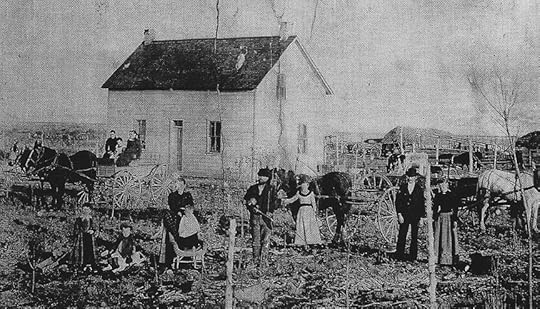
That was how Lorenzo Firth did it, though having a town named after him probably wasn’t his goal. He was a homesteader who had come over from Wakefield, England as young boy. He liked to tell the story about how he and a friend about his age were captured by Indians, who tied them to wild ponies and poked and prodded the horses to make them run and buck. The boys thought they were going to be killed, but the Indians turned them loose after they’d had their fun.
Firth worked on a ranch near Rock Springs (now Wyoming). It was there that he met and became friends with noted mountain man Jim Bridger.
Firth married Dorcas Martin in 1873 in Uinta, Utah Territory. They moved to Basalt, Idaho Territory in 1887. It was there that he homesteaded, with their land bisected by railroad tracks. The Oregon Shortline Railroad built a small depot near the Firth place and people began to call the stop Firth. When Lorenzo donated land for a school and town site, that sealed the deal. In 1905 the fledgling community was dedicated as Firth.
Pictured is the Lorenzo Firth homestead in 1894. Left to right in front are daughter Mabel Firth, son Thomas on the rocking horse, Marion Firth in the arms of her mother Dorcas, Lorenzo Firth, and his daughter Emma. Holding the horse team are Nels Fred Nelson and Mary Ann Firth Nelson. In the spring wagon is “Auntie Karr and daughter and person unknown.” The photo is courtesy of Marlene Reid from the book she and husband Wallace edited to celebrate Firth’s centennial in 2005.

Published on March 14, 2021 04:00
March 13, 2021
Falk's Store, Idaho
Falk’s Store was a place. That’s not an astonishing pronouncement but hold on. I don’t mean that it was a store, so thus a place. I mean that it was a store that became a town’s name: Falk’s Store.
Vardis Fisher’s 1938 Idaho Encyclopedia lists it as a ghost town in Payette County. I’ve seen it listed as “Falk Store,” and also under the town name “Falks.”
Nathan Falk, one of the brothers who owned what became known as Falk’s Idaho Department Store, or Falk’s ID, in Boise, had a store in Payette County that snagged the local post office for the community in 1872. Falk’s Store, which would lose its possessive apostrophe under naming conventions today, was located on the Payette River between Emmett and Fruitland.
Falk’s Store was also a station for the Utah, Idaho, and Oregon Stage Line, giving it a revolving customer base. In addition to its namesake store the town had a ferry, a hotel, a saloon, a blacksmith shop, and a boot and saddle shop.
Nathan Falk’s store is said to have prospered in Falk’s Store, Idaho for several years. A 1922 fire marked the end of town. Nothing remains of it today, although there is a nearby bridge that carries the name Falk's Bridge. The Falk’s Store in Falk’s Store, circa 1892. Courtesy of the Idaho State Historical Society Digital Collection
The Falk’s Store in Falk’s Store, circa 1892. Courtesy of the Idaho State Historical Society Digital Collection  An ad for the stores in Boise and along the Payette, 1874.
An ad for the stores in Boise and along the Payette, 1874.
Vardis Fisher’s 1938 Idaho Encyclopedia lists it as a ghost town in Payette County. I’ve seen it listed as “Falk Store,” and also under the town name “Falks.”
Nathan Falk, one of the brothers who owned what became known as Falk’s Idaho Department Store, or Falk’s ID, in Boise, had a store in Payette County that snagged the local post office for the community in 1872. Falk’s Store, which would lose its possessive apostrophe under naming conventions today, was located on the Payette River between Emmett and Fruitland.
Falk’s Store was also a station for the Utah, Idaho, and Oregon Stage Line, giving it a revolving customer base. In addition to its namesake store the town had a ferry, a hotel, a saloon, a blacksmith shop, and a boot and saddle shop.
Nathan Falk’s store is said to have prospered in Falk’s Store, Idaho for several years. A 1922 fire marked the end of town. Nothing remains of it today, although there is a nearby bridge that carries the name Falk's Bridge.
 The Falk’s Store in Falk’s Store, circa 1892. Courtesy of the Idaho State Historical Society Digital Collection
The Falk’s Store in Falk’s Store, circa 1892. Courtesy of the Idaho State Historical Society Digital Collection  An ad for the stores in Boise and along the Payette, 1874.
An ad for the stores in Boise and along the Payette, 1874.
Published on March 13, 2021 04:00
March 12, 2021
Rolling Into Idaho
In 2016, the US Census Bureau estimated the population of Idaho as 1,683,140. Meanwhile, the Idaho Transportation Department registered 1.7 million vehicles that same year. So, every man, woman, and child in the state could, theoretically, have their own set of wheels. Yet, it wasn’t that long ago there wasn’t a single wheel in sight.
The first wheel to enter what is now Idaho, was probably one of four on what was the first wagon to come here. That was in 1836, when the Reverend and Mrs. Henry Spalding (Eliza), accompanied by Dr. and Mrs. Marcus Whitman arrived in this land. They had run out of road when they hit the Green River in Wyoming, then struck out across country on their mission to spread their religion.
The missionaries got the wagon nearly to where Fort Hall had been established as a trading post two years earlier. The going got tougher, so they abandoned two of the wheels and converted their wagon into a cart. That got them at least to Fort Boise (the early version of same, which was also a fur trading establishment).
We’re only concerned with that first wheel today, so won’t tell more about the Spaldings and the Lapwai Mission printing press, or the demise of the Whitmans, which discouraged the Spaldings out of almost-Idaho in 1847. Not this time.
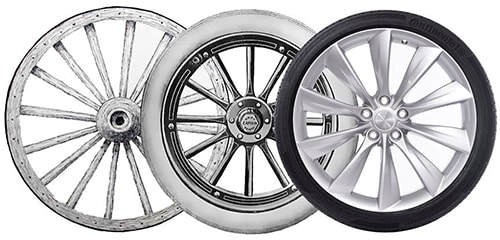
The first wheel to enter what is now Idaho, was probably one of four on what was the first wagon to come here. That was in 1836, when the Reverend and Mrs. Henry Spalding (Eliza), accompanied by Dr. and Mrs. Marcus Whitman arrived in this land. They had run out of road when they hit the Green River in Wyoming, then struck out across country on their mission to spread their religion.
The missionaries got the wagon nearly to where Fort Hall had been established as a trading post two years earlier. The going got tougher, so they abandoned two of the wheels and converted their wagon into a cart. That got them at least to Fort Boise (the early version of same, which was also a fur trading establishment).
We’re only concerned with that first wheel today, so won’t tell more about the Spaldings and the Lapwai Mission printing press, or the demise of the Whitmans, which discouraged the Spaldings out of almost-Idaho in 1847. Not this time.

Published on March 12, 2021 04:00
March 11, 2021
Bread Loaf Rock is Not Toast
Landmarks—even natural landmarks—can suddenly disappear, as New Hampshire’s Old Man of the mountain did not long ago. Today we’re giving a little digital tip of the hat to a landmark that is still there, but has vanished from view for all practical purposes.
Bread Loaf Rock was and is on the hillside between Horseshoe Bend and Boise in Boise County. You could look down from the roadway and see it, if you didn’t look too long and drive off one of the switchbacks. It looks like a bread loaf with the end slice cut off and ready to serve in front of it. In case you couldn’t see that for yourself, people used to paint the end of it white so it stood out. It’s still there, but that winding, sawdust-filled (really) road that kept slipping off the mountain is no longer the main route. The road is much improved, but the bread loaf is mostly hiding. You can still see it from a pullout, but the angle isn’t as good as it once was.
It’s not the most spectacular rock formation one could see, but countless kids enjoyed pointing it on road trips.
By the way, in looking for images of this I discovered that there are a few other rocks with that name around the country, including one at the City of Rocks National Reserve.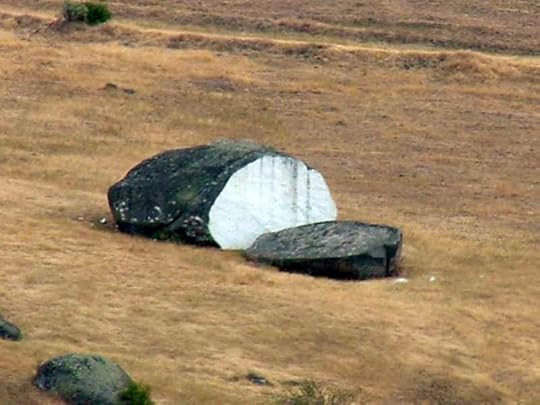
Bread Loaf Rock was and is on the hillside between Horseshoe Bend and Boise in Boise County. You could look down from the roadway and see it, if you didn’t look too long and drive off one of the switchbacks. It looks like a bread loaf with the end slice cut off and ready to serve in front of it. In case you couldn’t see that for yourself, people used to paint the end of it white so it stood out. It’s still there, but that winding, sawdust-filled (really) road that kept slipping off the mountain is no longer the main route. The road is much improved, but the bread loaf is mostly hiding. You can still see it from a pullout, but the angle isn’t as good as it once was.
It’s not the most spectacular rock formation one could see, but countless kids enjoyed pointing it on road trips.
By the way, in looking for images of this I discovered that there are a few other rocks with that name around the country, including one at the City of Rocks National Reserve.

Published on March 11, 2021 04:00
March 10, 2021
Charlie Pride in Idaho
Charlie Pride, who passed away in 2020, was best known as a country singer. He had 52 top 10 hits and won the Country Music Association’s Entertainer of the year award in 1971
Some also remember Pride as a pitcher who played in several pro baseball farm teams around the country and for the Negro League Memphis Red Sox.
Possibly 11 people remember him as a pitcher for the Boise Yankees of the Pioneer League in 1953. All 11 of those people and their descendants will likely comment on this post, filling in details that I don’t have, because few are available.
Charles Pride pitched for the Boise Yankees farm team for maybe a couple of months before being shipped off to a Wisconsin farm team. As far as we know, it was not a major memory in his life.
Charley Pride fans know he lived and worked in Montana for several years and launched his country music career from there. His baseball career never really got off the ground. Country music was all the better for that.
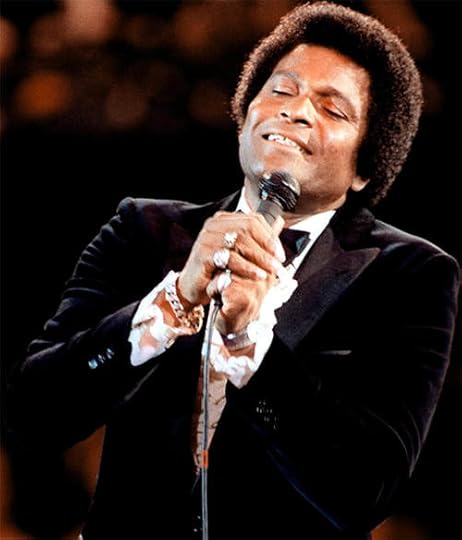
Some also remember Pride as a pitcher who played in several pro baseball farm teams around the country and for the Negro League Memphis Red Sox.
Possibly 11 people remember him as a pitcher for the Boise Yankees of the Pioneer League in 1953. All 11 of those people and their descendants will likely comment on this post, filling in details that I don’t have, because few are available.
Charles Pride pitched for the Boise Yankees farm team for maybe a couple of months before being shipped off to a Wisconsin farm team. As far as we know, it was not a major memory in his life.
Charley Pride fans know he lived and worked in Montana for several years and launched his country music career from there. His baseball career never really got off the ground. Country music was all the better for that.

Published on March 10, 2021 04:00



